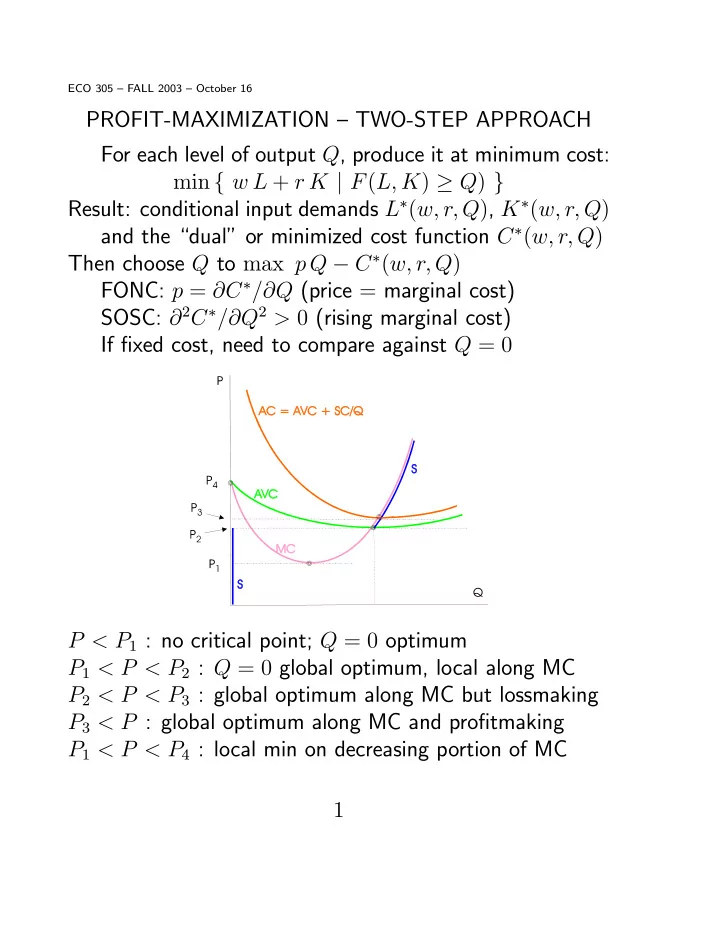

ECO 305 — FALL 2003 — October 16 PROFIT-MAXIMIZATION — TWO-STEP APPROACH For each level of output Q , produce it at minimum cost: min { w L + r K | F ( L, K ) ≥ Q ) } Result: conditional input demands L ∗ ( w, r, Q ) , K ∗ ( w, r, Q ) and the “dual” or minimized cost function C ∗ ( w, r, Q ) Then choose Q to max p Q − C ∗ ( w, r, Q ) FONC: p = ∂ C ∗ / ∂ Q (price = marginal cost) SOSC: ∂ 2 C ∗ / ∂ Q 2 > 0 (rising marginal cost) If fi xed cost, need to compare against Q = 0 P < P 1 : no critical point; Q = 0 optimum P 1 < P < P 2 : Q = 0 global optimum, local along MC P 2 < P < P 3 : global optimum along MC but lossmaking P 3 < P : global optimum along MC and pro fi tmaking P 1 < P < P 4 : local min on decreasing portion of MC 1
PROFIT MAXIMIZATION — SINGLE-STEP APPROACH max Π = p F ( K, L ) − w L − r K FONCs — price of each input = value of its marginal product p ∂ F/ ∂ L = w, p ∂ F/ ∂ K = r SOSCs — (1) diminishing marginal returns to each input, (2) diminishing returns to scale (this is not fully rigorous) Result - (unconditional) input demand functions L ∗ ( p, w, r ) , K ∗ ( p, w, r ) , yielding Q ∗ = F ( K ∗ , L ∗ ) Substitute in pro fi t expression to get “dual” pro fi t function Π ∗ ( p, w, r ) = p Q ∗ − w L ∗ − r K ∗ Properties of dual pro fi t function: (1) Homogeneous degree 1, and (2) convex in ( p, w, r ) (3) Hotelling’s lemma: Q ∗ = ∂ Π ∗ / ∂ p, L ∗ = − ∂ Π ∗ / ∂ w, K ∗ = − ∂ Π ∗ / ∂ r Proof of these follows same lines as those of concavity of expenditure functions - take initial ( p a , w a , r a ) and initially optimum L a , K a , Q a . Could go on using these when prices change, so new optimum choices should yield no less pro fi t. 2
EMPIRICAL ESTIMATION U.S. MANUFACTURING (Ernst Berndt, 1991) X ln C = ln( α 0 ) + α i ln( P i ) i X X + 1 γ ij ln( P i ) ln( P j ) 2 i j + α Y ln Y + 1 2 γ Y Y (ln Y ) 2 X + γ iY ln( P i ) ln Y i i , j = inputs K , L , E , and M X X α i = 1 , γ ij = γ ji , γ ij = 0 i i Find factor cost share functions and estimate, e.g. P L L = P L ∂ C = d ln C . C C ∂ P L d ln P L Results: Elasticities of substitution σ KL = 0 . 97 , σ KE = − 3 . 60 , σ KM = 0 . 35 , σ LM = 0 . 61 , σ EM = 0 . 83 , σ LE = 0 . 68 Own price elasticities of factor demands ² K = − 0 . 34 , ² L = − 0 . 45 , ² E = − 0 . 53 , ² M = − 0 . 24 . 3
CREDIT UNIONS (Moeller, Princeton Sr Thesis 1999) a + b 1 ln Q + b 2 (ln Q ) 2 ln C = X X + c i ln W i + d j ln F j + µ , i j where Q = size (output) of the credit union W i factor prices, F j other structural variables µ is stochastic error term. Results b 1 = 0 . 6537 with standard error 0.0231, b 2 = 0 . 0204 with standard error 0.0015. b 1 < 1 , b 2 > 0 : initial economies of scale and eventual diseconomies Averge cost is minimized when ln Q = (1 − b 1 ) / (2 b 2 ) = 8 . 48 , or Q = 4764 85% of U.S. credit unions were to the left of this. Median Q = 705 , AC penalty 7.8 %. 4
Recommend
More recommend